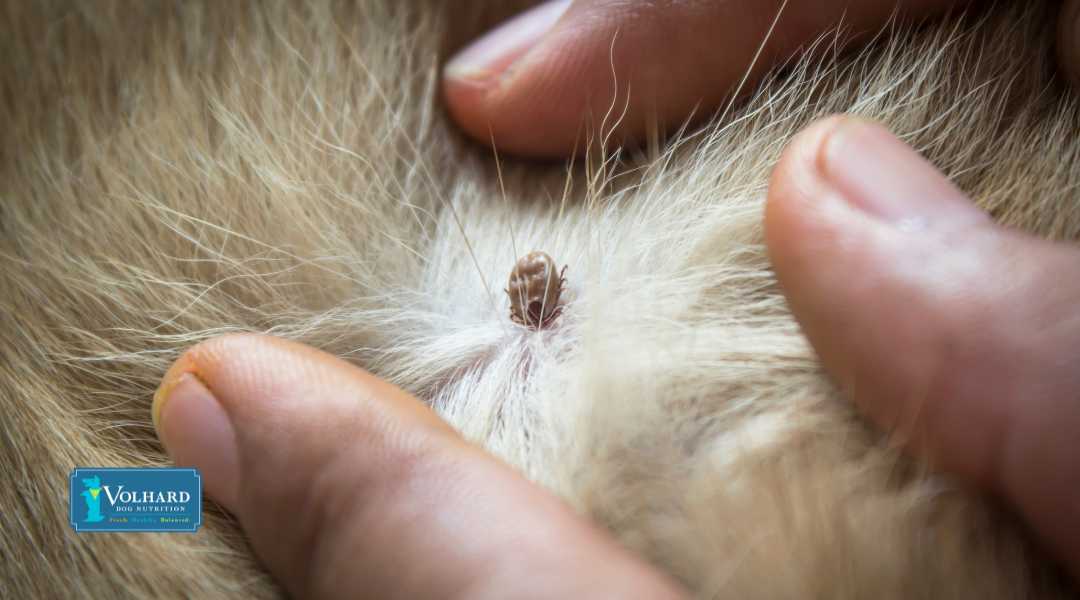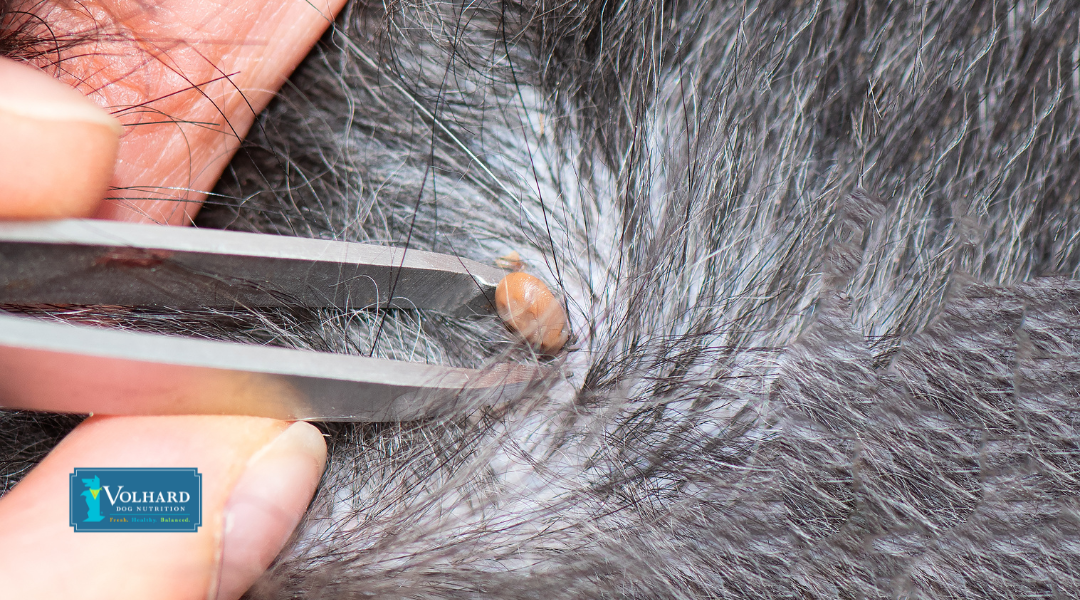How to Treat Lyme Disease in Dogs With 7 Home Remedies for Tick Prevention!
Posted by Volhard Dog Nutrition on Aug 21st 2025
Lyme disease ranks among the most common vector-borne diseases in the U.S.
Now that we’re deep in tick season, the chances of your dog falling prey to these potentially disease-ridden parasites and potentially becoming infected with a tick-borne illness are considerably higher.
Plus, your dog might already suffer from Lyme disease without you even knowing it, Lyme disease only causes symptoms in 5-10% of affected dogs.
It’s time for you to arm yourself with a proactive rather than a reactive approach to prevent Lyme disease from occurring in your canine friend to begin with.
Although you might be familiar with this disease, a more thorough discussion of the subject is necessary for dog parents to take rigorous care of their loyal companions.
How is Lyme Disease Transmitted?
Lyme disease is an infection caused by the bacterium Borrelia burgdorferi. These bacteria are usually present in specific parasites, such as the black-legged ticks (known as deer ticks or Ixodes scapularis) in the North and East of the U.S., and the western black-legged tick (or Ixodes pacificus) on the Pacific coast (ticks can be found throughout the U.S. territory).
Ticks attach themselves to the host’s (whether human, cow, deer, or canine) external tissue and begin to feed on its blood. The feeding process allows the bacteria and viruses dwelling within a tick to pass into the host’s body. Typically, the Borrelia bacterium requires 24-48 hours to pass to the host and cause infection. Aside from Lyme, the black-legged tick can also cause diseases such as:
Is Lyme Disease Zoonotic?
Can dog parents catch Lyme disease directly from their dog? The answer is no. Lyme disease is not spread from dogs to humans through casual contact.
Instead, both humans and dogs can be infected by the same source: the bite of an infected black-legged tick.
That means if your dog has Lyme disease, you won’t get it from them, but you should be cautious, because the ticks in your dog’s environment could also bite you.
Practicing good tick prevention for both pets and people is the best way to protect the whole family.

Symptoms of Lyme Disease in Dogs
Lyme disease has a series of common symptoms that appear in dogs, including, but not limited to:
- Swelling of the joints
- Recurrent lameness (particularly in different legs at different times)
- Limping
- Lethargy
- High fever
Lyme disease also manifests itself through more varied symptoms, including:
- Lack of appetite
- Walking stiff or with an arched back
- Breathing difficulties
- Brain fog
- Phantom joint pain that moves throughout the body
Complications from Lyme disease can target the dog’s kidneys. Bacterium causes dysfunction and inflammation in the kidney’s glomeruli (i.e., the network of blood vessels that filter the blood from liquids and other impurities).
The disease is called glomerulonephritis and is known to cause life-threatening conditions such as acute kidney failure, one of the most critical reasons to take potential Lyme infection seriously and to monitor your canine for symptoms regularly.
Are Antibiotics Enough to Treat Lyme Disease?
Initially, dog owners may be tempted to use antibiotics to treat Lyme disease in their canine companions.
Some antibiotics, such as doxycycline, amoxicillin, clarithromycin, and azithromycin, can alleviate Lyme disease symptoms and be part of a proper treatment regimen for humans and dogs.
However, antibiotics may not be sufficient for a complete eradication of Lyme disease. The Borrelia burgdorferi can survive some antibiotic treatments.
Even after an initial (seemingly successful) cycle of antibiotics, the same symptoms can return at a later date, together with new complications (e.g., development of kidney disease). As a dog parent, your best bet is to prevent the infection altogether.
Fortunately, there are multiple Lyme disease prevention tactics and products, of which we want to share the most effective.

Lyme Disease Prevention
The starting point lies in the 4DX Snap Test! This simple blood test done at your vet office can detect Lyme, Heartworm, Ehrlichia canis, Ehrlichia ewingii, Anaplasma phagocytophilum, and Anaplasma platys in just eight minutes.
In case of a positive result, further tests are required to ascertain the true culprit behind the infection. We recommend the C6 and CBC tests for more accurate results once your pet receives a positive 4DX test.
Tick bites occur suddenly, and the dog parent has to remain vigilant. Because of this, we advise dog parents to get their dog proactively tested at least once every six months (especially if not giving chemical preventatives) before the infection has enough time to cause severe complications.

7 Home Remedies for Tick Prevention
Frequently, dogs wander through woods with only their fur for cover while we coat ourselves with tick repellents for those same hikes. Dogs can benefit from these repellents as much as humans do, and some of them do work wonders! Let’s take a look at the most common examples:
#1: Essential Oils
Humans have used essential oils to naturally counteract ailments and as pest repellents for many centuries.
Their high concentrations and organic composition work like magic against specific parasites, such as ticks. For example, rose geranium, a sweet, strong-smelling essential oil, disturbs the tick’s sense of smell and causes it to leave its potential host alone.
Cedar oil is a natural biochemical insecticide that works by disrupting an insect’s pheromone-driven navigation and dehydrating their exoskeleton, leading to eventual death. It is particularly effective against ticks, mosquitoes, fleas, lice, and certain mites.
Many people use natural essential oil sprays that contain lavender, peppermint, citronella, eucalyptus, catnip, lemon, lemongrass, rosemary, melaleuca, oregano, palo santo, and basil to help repel mosquitoes, fleas, lice, and ticks.
#2: Homeopathics
The most efficacious homeopathic that works to heal bites from insects is Ledum. Its anti-tetanus properties are most effective against puncture wounds and bites from animals or insects, in addition to aiding in blood purification and alleviating chronic diseases. This makes it an excellent remedy for keeping Lyme disease at bay.
The recommended Ledum dosage for dogs is one homeopathic pellet of Ledum 200c twice per day for two days after the tick bite. Place the pellet in the dog’s mouth, dissolve it in a small amount of water, or add it to their food if necessary.
#3: Food-Grade Diatomaceous Earth
This natural remedy, made of ground fossils and single-celled algae, is rich with silica or silicon dioxide, one of the most abundant resources in the Earth’s crust. Once purified, diatomaceous earth acts as a dehydrating agent.
The parasite will lose its natural moisture and oils and perish. However, unlike the parasites they pick up, dogs and humans are too big to suffer from this dehydration process, making diatomaceous earth a powerful ally against ticks.
#4: Probiotics for Gut and Immune Health
A strong immune system starts in the gut. High-quality, dog-safe probiotics can help balance the gut microbiome, improve nutrient absorption, and boost your dog’s natural defenses.
Certain strains, such as Lactobacillus acidophilus and Bifidobacterium animalis, have been shown to support immune modulation, which is crucial when the body is fighting bacterial infections like Lyme disease.
#5: Omega-3 Fatty Acids for Inflammation Control
Lyme disease often causes joint swelling and discomfort. Adding omega-3-rich supplements such as Krill oil nourishes the skin and coat, which can help maintain a tick-resistant barrier.
#6: Immune-Boosting Herbs
Certain herbs can provide gentle, immune-supportive benefits:
- Echinacea – known for stimulating immune function
- Astragalus – supports resilience against infections
- Milk thistle – protects the liver, which works hard when the body is clearing infection
Always consult with your holistic veterinarian or a canine herbalist before introducing herbs, as dosage and form matter for safety and efficacy.
#7: A Fresh, Whole Food Diet
At Volhard, we believe that food is the foundation of health. Feeding a balanced, whole food diet rich in lean proteins, fresh vegetables, and species-appropriate fats can help keep your dog’s body strong and capable of fending off invaders.
Dogs in peak nutritional health are less likely to attract parasites and are better able to recover from illnesses when they occur.
Lyme Disease Vaccines for Dogs: What You Need to Know
As part of a broader tick prevention plan, some veterinarians may recommend a Lyme disease vaccine, particularly for dogs living in or frequently visiting areas where black-legged ticks are common. The vaccine is intended to help the immune system recognize and respond to the Borrelia burgdorferi bacterium before illness develops.
The process typically involves an initial two-dose series, spaced 2–4 weeks apart, followed by annual boosters. However, it is not a one-size-fits-all solution and should be considered based on individual risk.
Potential Side Effects
Like any vaccine, the Lyme vaccine can cause side effects. Most are mild and short-lived, such as:
- Soreness or swelling at the injection site
- Temporary fatigue or decreased appetite
- Low-grade fever
In rare cases, more serious allergic reactions can occur, including facial swelling, hives, vomiting, or difficulty breathing. Seek veterinary attention immediately if these symptoms appear.
Because the vaccine may not be necessary or beneficial for every dog, your veterinarian will weigh factors such as age, health status, lifestyle, and regional tick prevalence before making a recommendation. For dogs with minimal tick exposure or certain health conditions, the potential risks may outweigh the benefits.

What Happens if My Dog Gets Bitten by a Tick?
The crucial first step is for you to stay calm. Tick bites do not automatically translate into Lyme disease. On the contrary, as long as you act quickly, there is a good chance that your dog will go through this unfortunate situation disease-free. Prepare yourself to perform a DIY tick removal as soon as you spot one of these pests.
You will need the proper tick removal tools. Make sure that you have the following items on hand:
- Gloves (latex or rubber)
- Magnifying glass and a strong light source
- Tick removal tool
- Disinfectant (E.g., hydrogen peroxide)
- Small container for tick - or use a piece of tape
- Treats to reward your dog!
Do not attempt to twist or press the tick with the tweezers; instead, use a slow, straight pulling motion. Refrain from applying burning or irritating substances that might cause the tick to release its bowel contents and lead to an unwanted hypodermic effect.
The procedure will be successful only if you remove the whole body of the tick. If the head of the tick is already stuck in the dog’s skin, you will need to choose a different approach for removal.
Fortunately, tick removal remedies such as peppermint essential oil and silica are known to force the tick to detach itself from your dog effectively, so keep them on hand for such occurrences.
Once the tick removal procedure is successful, inspect the skin and ensure that no tick body parts are still attached.
With the tick out of the way, it’s time to disinfect the area. Three percent hydrogen peroxide is your best ally in this process since its oxygen concentration will eradicate the Lyme disease bacterium in its infancy. The antiseptic also has bleaching properties, so we recommend that you use it cautiously on black or dark-haired dogs.
Keep Your Dog Tick-Free and Thriving!
Keeping your dog Lyme disease-free is all about prevention and maintaining overall good health. As long as your dog is cared for and healthy, ticks will look for a host elsewhere.
Our Volhard team is ready to answer all of your questions surrounding Lyme disease symptoms and prevention, so feel free to contact us or check out our blog if you have more questions.
Volhard Dog Nutrition and its expert nutritionists offer online consultations to help more dog parents discover why, what, and how to feed their dogs the healthiest of foods!
Speaking to a Volhard nutritionist will help you understand the inseparable relationship between healthy food, a healthy body, and a healthy mind. If you're interested in contacting one of our Volhard nutritionists, don't hesitate to access our consultation page!

